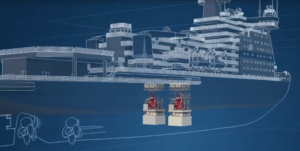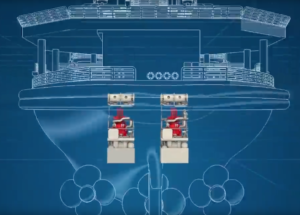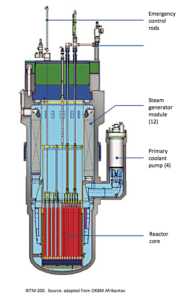Peter Lobner
The first ship in the new LK-60 class of nuclear powered icebreakers, named Arktika, was launched on 16 June 2016 at the Baltic Shipyard in St. Petersburg, Russia. LK-60 class icebreakers are powered by two RITM-200 integral pressurized water reactors (PWR), each rated at 175 MWt, and together delivering 60 MW (80,460 hp) to an electric motor propulsion system driving three shafts.
LK-60 class icebreakers are the most powerful icebreakers in the world. Contracts for two additional LK-60 icebreakers were placed in May 2014. They are scheduled for delivery in 2020 (Sibr) & 2021 (Ural).
The general arrangement of the nuclear reactors in these ships is shown in the following two diagrams.

 Two RITM-200 reactors installed on an LK-60 class icebreaker. Source: Atomenergomash
Two RITM-200 reactors installed on an LK-60 class icebreaker. Source: Atomenergomash
The basic design of the RITM-200 integral primary system is shown in the following diagram. The reactor and steam generators are in the same vessel. The four primary pumps are connected directly to the reactor vessel, creating a very compact primary system unit.
The two reactor vessels were installed in Arktika in September 2016, which is scheduled to be service-ready in mid-2019, and will operate from the Atomflot icebreaker port in Murmansk. Manufacturing of the reactor vessels for the second LK-60 icebreaker, Sibr, is in progress.
 Above: Second integral reactor vessel for Arktika, with the primary pump housings installed. Source: Rosatom
Above: Second integral reactor vessel for Arktika, with the primary pump housings installed. Source: Rosatom
Below: Integral reactor vessel at an earlier stage of manufacturing for Sibr. Source: Atomenergomash
Below: Complete RITM-200 integral reactor vessel. Source: Atomenergomash
You can watch an Atomenergomash video (in Russian) showing how the RITM-200 reactor vessel is manufactured at the following link:
The U.S. has no nuclear powered icebreakers and only one, older polar-class icebreaker. See my 3 September 2015, “The Sad State of Affairs of the U.S. Icebreaking Fleet and Implications for Future U.S. Arctic Operations,” for more information on the U.S. icebreaker fleet.
